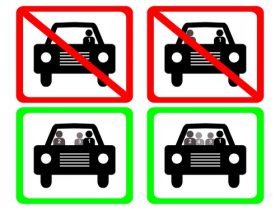A mobile technology “arms race” is underway as companies re-imagine their supply chains, incorporate more mobility solutions into those networks, and work harder to future-proof their business models.
By Bridget McCrea
Over the last few months, global supply chains have faced disruptions the likes of which most companies have never seen before.
Coming off of a year where labor shortages, an e-commerce boom, a shrinking pool of truck drivers, and trade wars were among their biggest challenges, shippers had a whole new set of issues hurled at them in early-2020.
With COVID-19 exacting a steep toll on human life, businesses, and livelihoods, some underlying supply chain issues became even more prominent. For example, e-commerce took off when people were at home or reluctant to shop at brick-and-mortar stores. Demand for buy online pick up in store (BOPIS) also accelerated, pushing retailers to get their collective “last-mile” and mobility acts together.
The good news is that the technology companies need to be able to operate efficiently in this “new normal” environment has been around for years. The not-so-good news is that many shippers were caught off guard by the pandemic and are now scrambling to implement solutions that help them gain better supply chain visibility and connectivity.
“The technology has always been there, but some companies are just further along and have been more innovative with it,” says David Krebs, executive vice president at VDC Research.
For example, COVID-19 accelerated the focus around driving visibility across operations and creating agile infrastructures. Combined, these two capabilities allow organizations to “more freely pivot,” says Krebs, “and leverage different fulfillment models.”
In response to market demand, technology vendors are introducing tools such as proximity solutions to alert workers when they’re not socially distancing—to the extent that this is even possible in certain work environments. “Education around disinfection best practices for shared technologies and devices has also been important,” Krebs points out. “The buzzword has clearly been ‘contactless,’ and we are seeing this pop up in all different scenarios and workflows—from delivery to point of sale.”
The connected fleet evolves
There was a time when shippers watched their goods leave their yards on a tractor trailer, lost visibility as they moved from point A to point B, and then picked visibility back up again when the trucks reached their final destination.
Fast forward to 2020 and the level of transportation visibility has vastly improved thanks to advancements in mobile technology. According to Bill Brooks, VP of Capgemini’s North American transportation portfolio, COVID has pushed more shippers to track their private and public fleets.
“COVID is basically driving a new norm as companies seek out ways to improve supply chain continuity in a safe manner that factors in everything that’s going on in our world right now,” says Brooks. “This trend is really going to take off over the next six to 18 months, with the connected fleet playing a huge part in that movement.”
Brooks sees data continuing to play a key role in supply chain mobility as companies focus on gathering, synthesizing, and utilizing their information. And while capturing and storing data is pretty straightforward, actually using it effectively isn’t always easy.
“As data continues to proliferate, companies have to do a better job of mining it, governing it, and getting it into the right hands at the right time,” says Brooks.
A multi-faceted animal, the connected fleet tracks everything from operational systems (i.e., preventative maintenance, hours of equipment usage, etc.), to accurate drive and ship times. It knows where any specific shipment is at all times and can convey that information back to the stakeholders who are asking for it.
More recently, companies have been incorporating elements of driver and employee safety into their connected fleets. If, for example, drivers know that they’re heading into a COVID hotspot, they can take the necessary precautions to help keep themselves, their shipments, or the end customer safe.
“The connected fleet takes a lot of those different elements and pulls them together onto a single platform,” says Brooks. “Technology vendors and shippers alike are getting innovative with their use of these connected fleets—versus just using them as pure tracking mechanisms.”
Today’s top mobility trends
According to VDC Research, overall investment in the warehousing space continues to grow and place pressure on optimized operations. The size and number of warehouses continue to rise, it says, as do the number of production and nonsupervisory employees in the warehouse along with their average hourly wages.
With 3.5 million warehouses currently operating globally, Krebs says the mobility trends taking place right now outside of their four walls include:
- Decentralization of manufacturing capacity, with companies looking to bring production home. “This trend grew with the likes of automation and small batch production,” says Krebs.
- Global firms will diversify their supply chains in the future, instead of relying only on China. “Manufacturing hubs such as Vietnam, Mexico and India are likely to benefit from that shift,” he predicts.
- Traceability and serialization efforts to extend beyond pharmaceuticals and into fresh foods and other segments. For example, programs are being rolled out to match food service distributors with excess capacity food retailers and wholesalers that require additional resources.
- Continued capacity strain on last-mile delivery services. As more people shop from home, the “last-mile” simply can’t be a black hole in the supply chain anymore. Companies are using mobility solutions to gain visibility into this critical area.
- An accelerated push toward digital services and paperless processes. “This is also opening the door for example for blockchain solutions for supply chain,” says Krebs, “and especially in areas that have held centralized governance models.”
- Re-imagining forecasting algorithms and the application of artificial intelligence (AI) to digitize inventory data. This trend accelerated when the global pandemic pushed the world’s supply chains and inventory stockpiles to their limits.
- Renewed focus on frontline workers. Ensuring the health and continuity of the food supply chain has shifted focus to a new class of “essential” workers. “As a result,” says Krebs, “supply chain security and workforce management are becoming ever more critical.”
Taking it to the air
Once considered something of a futuristic novelty, the airborne drone is proving its potential for the post-COVID, mobile supply chain—where contactless deliveries and social distancing are a normal part of our everyday lives.
Gartner predicts that by 2026, more than one million drones will be carrying out retail deliveries—up from 20,000 drones today. The global pandemic is a big driver of drone usage right now. For example, Zipline is using contactless drone delivery to transport COVID-19 test samples in remote locations across five African countries, and Chile recently launched a pilot drone program to deliver medications to people living in remote rural areas.
“The coronavirus pandemic has frozen much of the world’s aviation industry and grounded fleets,” Gartner states. “As a result, it has accelerated the use of autonomous flying drones in a humanitarian effort to beat the crisis.”
Beyond the pandemic, Gartner says that companies can consider autonomous flying drones as an opportunity to offer a premium service, like a fast-delivery option. For example, Spanish auto manufacturer SEAT uses drones to fly airbags and steering wheels from a supplier to its Martorell factory. A truck would take 90 minutes from order to delivery, but the drone can make it in just 15 minutes.
“Overall,” Gartner says, “the success of flying drone deliveries depends on a company’s ability to change its business model to make the most of the possibilities enabled by the technology.”
Get in the arms race now
Right now, the key requirement for supply chain operations is real-time visibility into operations and systems that can provide insight into capacity constraints across all supply tiers. This is often easier said than done, says Krebs, but it’s something shippers should be striving for.
Going forward, Krebs expects solutions that provide greater predictive intelligence to be in high demand, and especially solutions that can find patterns or indicate risk/opportunities. In addition, he says capacity strain on last-mile delivery is increasingly acute and an area of focus.
“Equipping essential frontline workers with the necessary digital and mobile tools to do their jobs and ensure worker safety are also areas where we see continued investment,” Krebs points out. “With e-commerce giants like Amazon continuing to build out their logistics infrastructure and becoming a more competitive threat to incumbents, we see a technology arms race developing.”
Getting in on that race will require an approach that thinks beyond what companies were doing just four or five years ago in this realm. Coming off an 11-year-long period of economic prosperity—and now re-imagining their business models for a post-COVID world—shippers are merging advanced technology tools with “lessons learned” to future-proof their supply chains.
“Embrace the change that’s coming and apply it to your new future and new norm,” Brooks advises. “In the end, it’s the companies that say: ‘Okay, if we do A, B and C we’ll be able to get out on the cutting edge,’ that will be more efficient, effective, and profitable.”
Link:https://www.logisticsmgmt.com/article/mobility_the_strongest_link_in_connected_supply_chain
Source: https://www.logisticsmgmt.com
















Leave a Reply